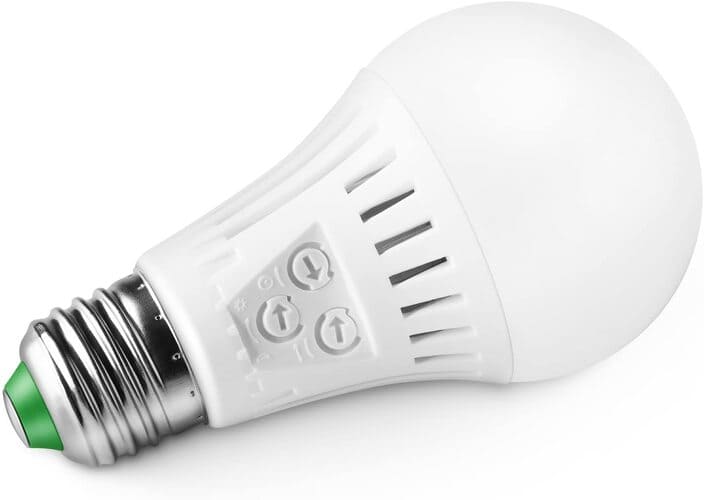*When you buy through links on our site, we may earn an affiliate commission at no additional cost to you.
Did you know that working in a poorly lit office can take be a health hazard?
Well, bad home office lighting can cause eyestrain, headaches (ouch!), and even shoulder and neck pains as you’re forced to sit in uncomfortable positions in your office chair.
Not to forget, poor lighting kills your productivity fast!
That said, poor lighting manifests in different forms including insufficient illumination, improper contrast, uneven light distribution, glare, blind spot, etc.
Below, we have shared expert tips to help you combat the issue of poor home office lighting, lighten up things in your office, and boost your work rate.
Table of Contents
Tip #1. Make full use of natural lighting
One of the simplest but most effective ways of improving lighting in your home office is by utilizing daylight.
If your home office doesn’t have access to the daylight—whether it’s through the window, skylight, or any other portal—then it’s time you rethink your setup. The sunlight will serve your home office with a warm illumination that will greatly improve the working environment.
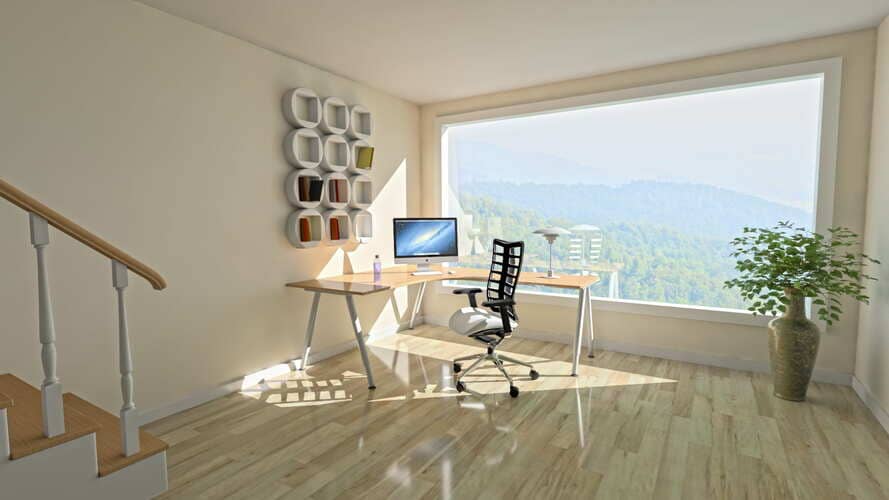
So, how exactly do you tap this beautiful sunlight?
If the sunlight in your office comes through the window, we advise you to place your office furniture or simply the work desk under your window so that the natural light is in front of you.
Another option involves placing your work desk or computer next to the sunlight as a measure to minimize glare and maximize your outside view.
If your office space allows, you might also consider setting up your workstation facing north or south to enable you to enjoy the daylight without it casting shadows at any time throughout the day.
In a working space where sunlight is inaccessible, e.g. in your basement, you can install tubular skylights in the roof to bring daylight right into your room through reflective action.
You could also get solar shades to help you reduce the heat that comes with daylight without compromising the view and daylight.

However, you might want to avoid direct sunlight as much as possible as it’s known for creating overwhelming glares at various times of the day.
FUN FACT: Natural light has been shown to increase your brain’s production of serotonin—the mood-enhancing chemical [1].
When you’re in happy moods, your work output goes above the ceiling!
Tip #2. Keep your office ambient lighting indirect
Another crucial practice that will go a long way in helping you improve your home office lighting ideas is to avoid direct light sources illuminating your work and use indirect lighting instead.
Direct lighting sources could be anything from recessed lights, pendants, ceiling fan lights, or even chandeliers.
The reason you want to avoid these direct light sources is that they can easily cast shadows and glares onto your work area. They can also produce a lot of bright that can make it challenging for you to work in your home office.
What should you do instead of direct illumination?
It’s simple; illuminate your room with an indirect lighting source. And you can easily achieve this by using table lamps task lamps, floor lamps, etc.
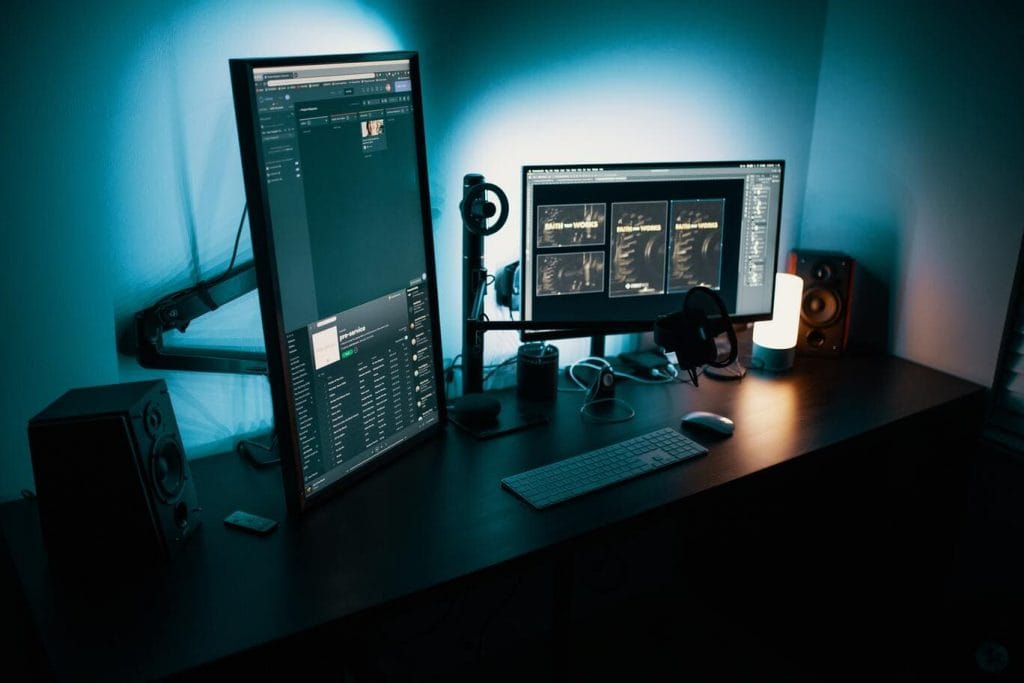
Lights that come with shades are good at diffusing the ambient light across your room and minimizing the chances of shadows and glares forming.
Quick Tip: If you are always on video calls, go for a soft indirect light source option to help you look your best on the calls.
Tip #3. Set up task lighting for each workstation
If your home office accommodates a lot of activities and features multiple workstations for various projects, then it would be wise to set up a task lighting dedicated to each workstation.
For instance, you can have one task light illuminating your computer work, another illuminating where you handle your paperwork, a task light for your drawing table, filing, and so on.
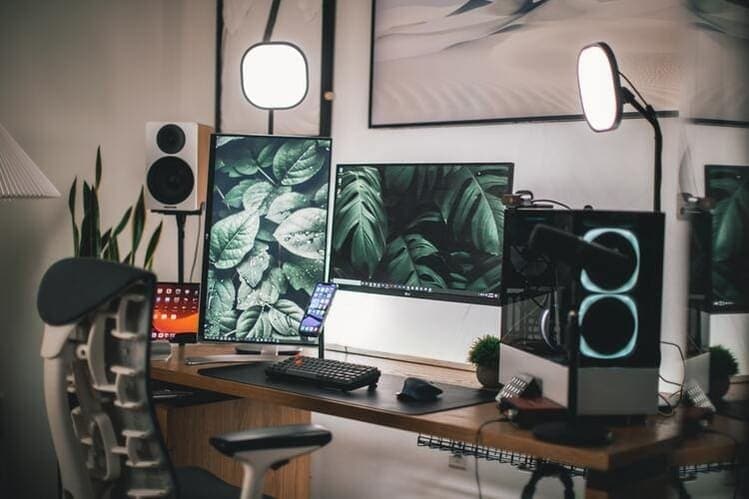
The joy of using a dedicated task lamp is that it lets you focus the light right where you want it. Most of the table lamps are easily adjustable, making it easy for you to pinpoint the light exactly where you want it to go.
Task lighting also comes in handy for late-night working, when you don’t want a lot of light in your office and just want to illuminate your specific tasks.
Whatever task lighting you choose for your home office, make sure it produces an ample amount of light and minimal glares.
Tip #4. Correct placement of light in your home office
As we mentioned at the beginning of this post, shadows and glares are some of the forms through which bad lighting manifests in your home office.
With that said, the placement of lighting solutions in your office will be crucial in reducing glare and shadows in your work area. If you have an overhead light located behind you when working on your computer, then it will most certainly create a glare on your computer monitor.

Also, the table light you use on your table can create annoying shadows that can result in eyestrain.
Don’t believe it? Consider a sensation where you’re right-handed. Placing the lamp on your right-hand side will make your right hand and arm create a shadow on your worktop.
Solving this is as easy as placing the task lamp on the opposite of your dominant hand (or the hand you write, draw, or type with).
Tip #5. Introduce smart lighting into your home office
Daylight is a wonderful source of home office lighting. But the truth about this light source is that it is only helpful when the sun is shining.
For this reason, you should complement your daylight with a smart light with built-in daylight sensing control.
This device will simply turn your office lights on and off relative to the amount of daylight available in your office.
This smart bulb is advantageous in that it will automatically turn off lights when not needed and help bring down your utility bill by a significant value.
Tip #6. Spice it up with some decorative lighting
Having worked on the natural light, ambient lighting, and task lights aspects, you’d now want to think of some decorative ideas to improve the overall visual character of your office.
But keep in mind that these are only decorative and don’t serve any specific function like the task light.
For instance, you can introduce accent lighting types like the mantel, wall scone fixtures, a floor lamp, picture lights, etc., to help easily highlight specific elements or things in your home office and make your home office space more appealing.
Tip #7. Go for cool temperature lighting
When it comes to proper home office lighting, the color quality of your light bulb also matters. The bulb color temperature is usually expressed in Kelvin; the lower this value gets, the warmer the color temperature a bulb produces
All the lights rated below 3000 Kelvin are labeled warm, meaning they produce red or yellow light.
Any bulb with 3,000 to 4600 Kelvin will produce cool white light.
Any bulb from 4,600 and higher will deliver the coolest colors. All the models in this category are usually referred to as cool or daylight.
Studies have shown that you can increase your home office productivity by using cool bulbs—the cooler it gets, the more you output [2]. You can also utilize can lighting along with these LED bulbs. The higher Kelvin rating ( 5,000K) provides a brighter, more natural light, which provides an optimal environment for higher focus and concentration.
As a matter of fact, super-cool bulb options (with a 17,000 Kelvin rating) have been shown to significantly increase your mental activity, reduce eye strain, headache, and fatigue.
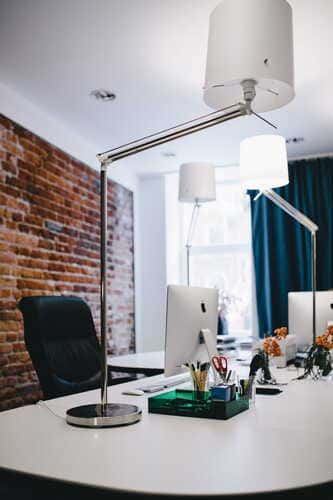
Just like the natural light, working under a cool color rated bulb will make you feel happier and more alert!
Tip #8. Get rid of annoying lighting
In your efforts to make your workspace lighting better, you shouldn’t spare any lighting fixtures that you think are annoying or a source of distractions for you.
Start with any buzzing ballasts and flickering light bulbs and replace them with bulbs that work quietly and steadily. LED options, in particular, will work without producing any distracting noise or annoying flickering.
With a quiet and steady kind of home office lighting lighting, your working space will become more enjoyable and you’ll be motivated to work more.
Tip #9. Lighting idea for small home offices
Let’s be honest…Not all of us have spacious home offices. If you fall in the category of folks with the small home working room design, then your lighting fixtures might be a bit different to prevent clutter.
You should consider looking for a space-saving kind of light to help you maximize your workspace while still achieving your goal of better home office lighting lighting.
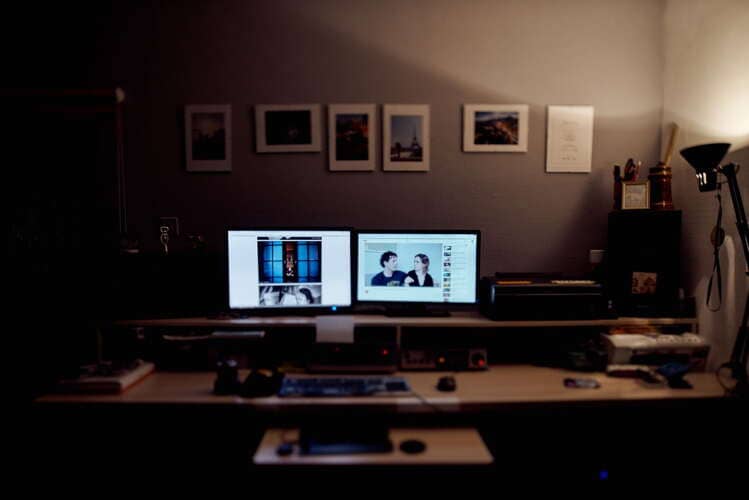
Some of the space-saving light options to consider include the scones, hanging, light strips that you attached underneath your cabinet, or mounted task lighting.
Scones, an accent lighting option, will work great in a small workroom. The LED strips option will help you maximize every inch of your small home working space.
Conclusion – Home Office Lighting Ideas
That’s all about home office lighting ideas. These expert tips will improve your home office lighting and eliminate all health hazards caused by imperfect lighting.
Check out more home office ideas.
Remember to make utilize the sunlight, avoid direct ambient lighting sources, use task lighting types for specific tasks, get rid of all possible glares and shadows in your home. And add some decorative light and accent lights to build your workroom visual character.
If you implement these tips today, you’ll easily turn your office into a more enjoyable working space, lighten up things, and you’ll not have to strain your eyes anymore or deal with never-ending headaches.

